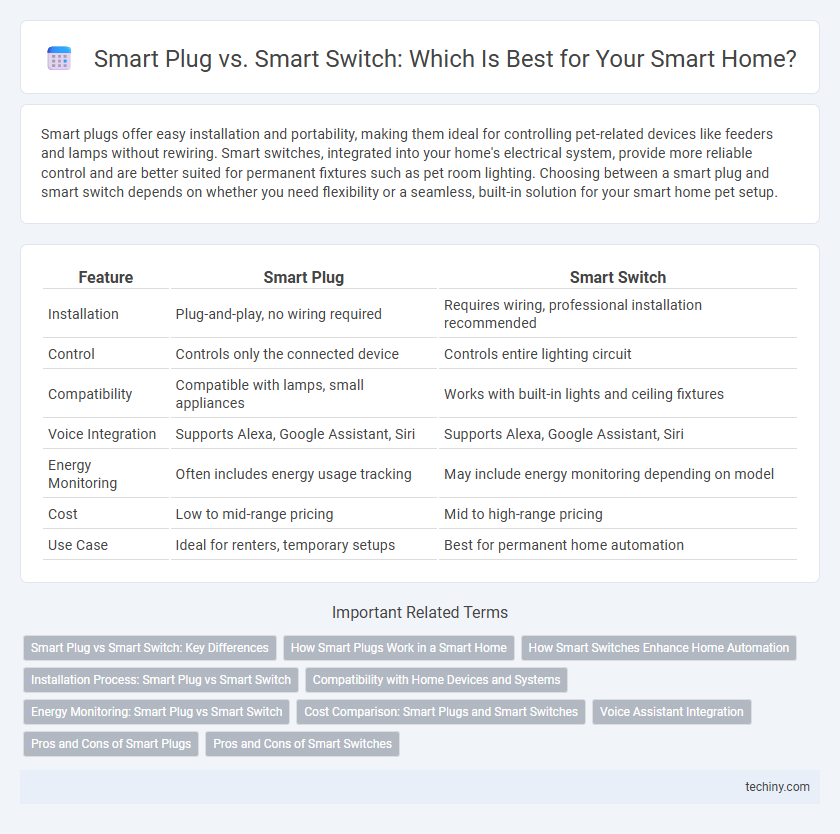Smart plugs offer easy installation and portability, making them ideal for controlling pet-related devices like feeders and lamps without rewiring. Smart switches, integrated into your home's electrical system, provide more reliable control and are better suited for permanent fixtures such as pet room lighting. Choosing between a smart plug and smart switch depends on whether you need flexibility or a seamless, built-in solution for your smart home pet setup.
Table of Comparison
| Feature | Smart Plug | Smart Switch |
|---|---|---|
| Installation | Plug-and-play, no wiring required | Requires wiring, professional installation recommended |
| Control | Controls only the connected device | Controls entire lighting circuit |
| Compatibility | Compatible with lamps, small appliances | Works with built-in lights and ceiling fixtures |
| Voice Integration | Supports Alexa, Google Assistant, Siri | Supports Alexa, Google Assistant, Siri |
| Energy Monitoring | Often includes energy usage tracking | May include energy monitoring depending on model |
| Cost | Low to mid-range pricing | Mid to high-range pricing |
| Use Case | Ideal for renters, temporary setups | Best for permanent home automation |
Smart Plug vs Smart Switch: Key Differences
Smart plugs offer a simple way to control individual devices by plugging them into the outlet, providing remote on/off functionality without rewiring, making them ideal for renters and easy installation. Smart switches replace traditional wall switches, enabling control of entire lighting circuits and integration with home automation systems but require professional installation due to electrical wiring. The key difference lies in installation complexity and control scope: smart plugs control single appliances, while smart switches manage whole lighting setups.
How Smart Plugs Work in a Smart Home
Smart plugs connect to standard electrical outlets, enabling remote control and scheduling of appliances through a smartphone app or voice assistant, optimizing energy consumption and convenience. These devices monitor power usage and integrate seamlessly with smart home ecosystems like Alexa, Google Home, or Apple HomeKit, allowing automation tailored to user habits. Smart plugs offer plug-and-play installation without altering existing wiring, making them ideal for renters seeking energy-efficient solutions.
How Smart Switches Enhance Home Automation
Smart switches enhance home automation by providing seamless control over wired lighting circuits, allowing users to manage multiple fixtures with a single device. Unlike smart plugs, smart switches integrate directly into existing electrical wiring, enabling voice commands, scheduling, and remote access without bulky adapters. Their compatibility with various smart home ecosystems improves energy efficiency and convenience by automating lighting based on occupancy, time, or user preferences.
Installation Process: Smart Plug vs Smart Switch
Smart plugs offer a simple installation process, typically requiring just plugging the device into an existing outlet and connecting it to a Wi-Fi network. Smart switches demand a more involved setup, often requiring wiring inside the wall and compatibility with a neutral wire in the switch box. Homeowners without electrical experience may find smart plugs more convenient, while smart switches deliver a cleaner, built-in solution for controlling hardwired fixtures.
Compatibility with Home Devices and Systems
Smart plugs offer broad compatibility with various home devices and systems, easily integrating into existing outlets without rewiring. Smart switches require professional installation but provide seamless control over hardwired lighting circuits, supporting multiple types of bulbs and smart home ecosystems like Amazon Alexa, Google Home, and Apple HomeKit. Choosing between them depends on whether you need flexible plug-in solutions or centralized control over fixed lighting fixtures.
Energy Monitoring: Smart Plug vs Smart Switch
Smart plugs offer precise energy monitoring by tracking the power consumption of individual devices, enabling users to identify energy-hungry appliances and optimize usage. Smart switches, integrated directly into the home's electrical wiring, provide energy data at the circuit level, which is ideal for overall room or device group monitoring but less granular than smart plugs. For detailed, device-specific energy insights, smart plugs are more effective, while smart switches are better suited for broader energy management and automation within a smart home system.
Cost Comparison: Smart Plugs and Smart Switches
Smart plugs typically cost between $15 and $40, making them a budget-friendly option for adding smart control to individual appliances without complex installation. Smart switches range from $40 to $100 or more, reflecting their integration into existing home wiring and ability to control entire lighting circuits. The higher upfront cost of smart switches is often offset by their broader functionality and seamless home automation compatibility.
Voice Assistant Integration
Smart plugs offer seamless voice assistant integration with platforms like Amazon Alexa, Google Assistant, and Apple HomeKit, enabling easy control of individual appliances through simple voice commands. Smart switches, often requiring hardwired installation, provide broader control over built-in lighting circuits and support multi-room voice automation for enhanced home ambiance. Both devices enhance smart home ecosystems by allowing hands-free operation, but smart plugs excel in plug-and-play voice control without electrical expertise.
Pros and Cons of Smart Plugs
Smart plugs offer easy installation and portability, allowing users to control appliances without rewiring or professional help. Their main downside is limited compatibility with built-in lighting fixtures and potential bulkiness, which can block adjacent outlets. Ideal for renters or those seeking flexible device management, smart plugs provide energy monitoring but may lack the seamless integration of dedicated smart switches.
Pros and Cons of Smart Switches
Smart switches offer seamless integration with existing wiring, providing control of multiple devices without occupying outlet space, enhancing convenience and aesthetic appeal in smart home setups. They support features like remote access, scheduling, and voice control, but installation often requires electrical knowledge and may pose challenges for renters or those without neutral wires. While more expensive than smart plugs, smart switches provide a centralized and permanent solution for managing lighting and appliances.
Smart Plug vs Smart Switch Infographic

 techiny.com
techiny.com